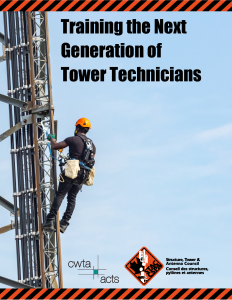 A new report aims to encourage and assist the development of comprehensive training programs for the next generation of telecommunications tower technicians. According to the release, “As the demand for wireless services in Canada continues to accelerate, so grows the demand for skilled technicians trained to build and maintain the country’s telecommunications towers and other critical wireless infrastructure.”
A new report aims to encourage and assist the development of comprehensive training programs for the next generation of telecommunications tower technicians. According to the release, “As the demand for wireless services in Canada continues to accelerate, so grows the demand for skilled technicians trained to build and maintain the country’s telecommunications towers and other critical wireless infrastructure.”
I have written before about the Structure, Tower and Antenna Council (STAC), which represents and provides a collaborative forum for Canadian wireless communications carriers, tower owners/operators, tower and rooftop equipment engineering service suppliers, and wireless communication facilities construction and maintenance contractors.
STAC released “Training the Next Generation of Tower Technicians” to aid in the development of a standardized training curriculum for new telecommunications tower technicians. The hope is that this will aid post-secondary educational institutions and specialized training schools to train the next generation of this in-demand workforce, supporting the growing need for wireless
connectivity.
Following lengthy deliberations, including research and interviews with people involved in launching similar training in the US, STAC identified six primary areas of study for those training to become tower technicians, as well as corresponding subtopics per each subject:
- An Introduction to Telecommunications;
- Climbing and Safety;
- Measurements;
- Construction;
- Rigging; and
- Electrical and Radiofrequencies (RF) Safety.
The structure, tower and antenna industry faces unprecedented recruitment challenges regarding the supply of workers, critical to meeting a continually growing demand for wireless services. In the absence of standardized industry training, employers are hiring and training new technicians themselves. As a result, there can be disparities, not only the types of training, but the scope and quality of training provided to new employees entering the industry.
As with any specialized workforce, the lack of adequate, standardized training can potentially result in hazardous working conditions. Harmonizing training and skills requirements for those joining the industry can help ensure critical communications infrastructure will be constructed with paramount concern for worker safety and network quality. Following completion of the classroom and lab-based learning modules, STAC’s Industry Workforce Committee believes additional structured learning through the completion of workplace learning placements, such as coop programs, would be beneficial to students, allowing for experience-based learning on-site, and providing students with an opportunity to develop hands-on knowledge of the job.
STAC indicated that it is eager to assist educational institutions and training providers seeking to offer this curriculum to develop the next generation of tower technicians.
Which schools will step up?
